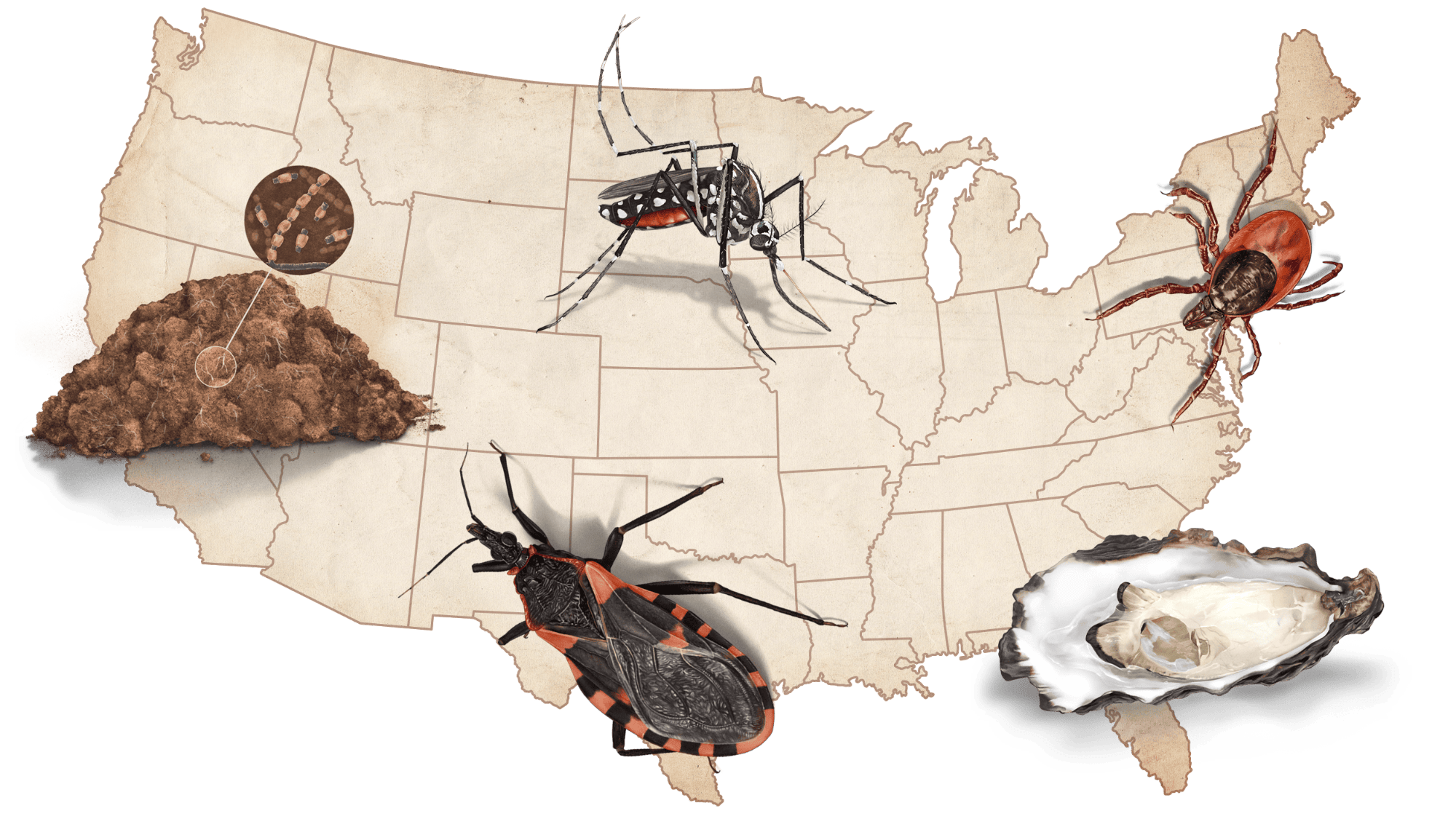In early July, New York City health officials conducting routine tests on the city’s mosquito population found a concerningly large number were carrying West Nile virus. The virus, which originated in the Eastern Hemisphere and is spread by Culex mosquitoes, was first detected in New York in 1999. In the decades since, the city had honed its response down to a science. Officials considered data on the concentration of mosquitoes, along with the vulnerability of the neighborhood to infection, to decide what to do next. On the night of July 15, trucks trundled down residential neighborhoods in the borough of Queens for the first time this summer, fogging the air with a mix of pesticides meant to kill the mosquitoes before they could spread the virus to humans.
Spraying pesticides to kill fully-grown mosquitoes, a technique known as adulticiding, is a central pillar of cities’ public health strategy as mosquito populations expand, migrate to new areas, and appear earlier in the season, driven in part by a changing climate. Some of them are spreading diseases that were previously limited to tropical areas, like West Nile, malaria, and dengue. An outbreak of the rare but deadly eastern equine encephalitis, or EEE, is currently underway in the Northeast; one person in New Hampshire and another in New York have died of the disease.
But the use of toxic chemicals to control mosquito populations — which officials say is necessary to safeguard public health — has long run into opposition from environmental and community groups, who say that the strategy endangers the very neighborhoods it’s meant to protect. They argue that the potential health effects of these substances, particularly on the endocrine system, are not taken into account when planning mosquito control strategies, and urge public agencies to focus more on prevention and public education. Jay Feldman, director of the environmental group Beyond Pesticides, called the rise in mosquito-borne illnesses “a concern that must be taken seriously,” particularly as climate change increases pressure on governments to protect vulnerable people.
“But like other decisions to use toxic chemicals over broad swathes of the population, those decisions have to be made with transparency,” Feldman said. “And that’s where I think we have failed the public.”
Patrick Pleul / picture alliance via Getty Images
Americans have long sought to combat the nuisance — and public health threat — posed by mosquitoes through spraying. In the 1950s and ’60s, trucks spread dichloro-diphenyl-trichloroethane — an insecticide developed in the 1940s and known more commonly as DDT — across farm fields and residential neighborhoods, aiming to combat diseases like malaria and typhus. It was banned nationwide in 1972 after Rachel Carson exposed its harmful effects on wildlife in her book Silent Spring, jumpstarting the environmental movement. But even after DDT was phased out, adulticiding with other chemicals remained common, both by public agencies and by pest control companies like Orkin and Terminix.
City and county public health departments and mosquito control agencies across the country utilize adulticiding in combination with other tools. These include larvicide — chemicals that kill mosquito larvae before they have a chance to develop into adults, and are typically less toxic to other organisms than adulticides — and eliminating mosquito habitat, such as pools of standing water. The New York City Department of Health has sprayed adulticides 137 times between 2018 and 2023, according to city data, and another 20 times this year. There are more than 1,100 vector control agencies around the country, and many of them utilize adulticides, including in California, Florida, and Texas.
The main goal of mosquito spraying programs is to prevent the outbreak of diseases like West Nile virus, which has killed more than 2,300 people across the United States over the past 25 years. The CDC has so far reported 748 cases of West Nile virus this year in 43 states, while deaths have occurred in states ranging from Illinois to Mississippi to New Jersey.
Climate change is now supercharging the spread of diseases like West Nile, as warmer temperatures push mosquitoes to develop faster, bite more frequently, and become better incubators for viruses. Milder winters allow disease-carrying mosquitoes to survive into the following summer, while increased rainfall — like that recently unleashed across the South by Hurricane Helene — creates standing pools of water that serve as breeding grounds for the insects. Earlier hurricanes, meanwhile, are driving outbreaks in damaged areas. Other factors are at play, too; growing urbanization is also putting mosquitoes in more frequent contact with humans, while the decay of leftover amounts of DDT in the environment has allowed populations of the insect to rebound.
“We have to be more aggressive,” New York City Health Commissioner Ashwin Vasan told Grist about the city’s mosquito control efforts this year, when officials have had to increase spraying as well as other measures in response to higher-than-normal rates of West Nile virus in the mosquito population. “This is now the new normal in terms of what public health looks like in the face of a changing climate.”
But as the need to deal with deadly mosquitoes grows more urgent, advocates are calling for officials to take a closer look at the application of adulticides, raising concerns about their potential harms to human health and the environment. The main adulticides used by the New York City health department are Anvil 10+10 and Duet, both of which contain synthetic pyrethroids, a class of chemicals that kill insects by targeting their nervous system. Pyrethroids such as sumithrin, the active ingredient in both Anvil 10+10 and Duet, are also endocrine disruptors, which can mimic hormones in the body and are particularly dangerous to unborn children. A study published in May in the journal Frontiers in Toxicology found that although data on the health impacts of endocrine-disrupting pesticides is scarce, pyrethroids have been associated with lower sperm count in men.
The U.S. Environmental Protection Agency does not screen pesticides for their potential effects on the endocrine system. Feldman of Beyond Pesticides said that means compounds like Anvil 10+10 shouldn’t be considered safe just because they’re approved by the federal government. Other chemicals present in the insecticides have also been linked with health problems; the cancer-causing “forever chemicals” known as PFAS have been found in pesticides including Anvil 10+10, mainly from storing them in shipping containers coated with the substances. Anvil also contains piperonyl butoxide, an additive used to increase the potency of the pesticide, which the EPA considers a possible human carcinogen.

Edwin Remsberg / VWPics / Universal Images Group via Getty Images
New York City’s health department says mosquito spraying takes place at low enough concentrations that it does not pose a danger to human health, although the agency recommends people stay indoors while their neighborhoods are being sprayed and warns that people with respiratory conditions or others “who are sensitive to spray ingredients may experience short-term eye or throat irritation, or a rash.” An environmental impact statement conducted by the city in 2001 concluded that any adverse public health effects from adulticides “would not be considered significant” compared to the risks to public health from allowing mosquitoes to proliferate.
Clarke, the manufacturer of Anvil 10+10 and Duet, told Grist that its products were reviewed by the EPA and that “adult mosquito control — used in concert with larviciding and source reduction — is the best tool to reduce adult mosquito populations in areas experiencing an outbreak.” A Clarke spokesperson also told Politifact last year that droplets of the company’s pesticides are specifically designed to work on mosquitoes, and that they break down once they touch the ground.
But advocates say adulticides are at best a temporary solution because of the tendency of mosquitoes to evolve resistance to these substances. Recent research from Arizona State University found that some mosquitoes are becoming resistant to the main pesticides used to control them. This creates a “treadmill effect,” Feldman said, where greater amounts of chemicals, as well as new kinds of pesticides, are needed to kill increasingly tolerant insects.
In its 2024 Comprehensive Mosquito Control and Surveillance Plan, New York City said it only applies adulticides as a last resort. This reflects best practices in the mosquito control industry, said Dan Markowski, the technical advisor for the American Mosquito Control Association, a professional association of mosquito control workers, public agencies, and private mosquito control applicators across the country, which receives funding from pesticide makers including Clarke. The organization is working to build a nationwide database for mosquito surveillance, track pesticide resistance, and develop a model for spraying based on real-time weather data, with the goal of helping its members target and reduce their adulticide use.
“No one wants to apply pesticides in a wide area, but you very often have to because none of the other methods are 100 percent effective,” Markowski said. “And when you have an outbreak … at that point, you don’t have a lot of other options.”
Some governments are also experimenting with releasing genetically modified mosquitoes into the wild to breed sterile offspring, reducing mosquito populations. Nanopesticides, which are less toxic to mammals but still affect mosquitoes, are also a promising area of research. However, advocates say that the most proven way to deal with mosquitoes is by reducing their ability to breed — by clearing away pools of standing water and utilizing larvicides — and educating the public to protect themselves using long clothing and repellents.
Feldman pointed to the success of programs in cities like Boulder, Colorado, and Washington, D.C., as proof that adulticides don’t need to be a major part of mosquito control efforts. The agency responsible for tracking and preventing the spread of West Nile virus in the nation’s capital, for example, does not use adulticides; instead, the D.C. Department of Health concentrates its efforts on larviciding, even handing out free larvicides for residents to apply in their own neighborhoods. Boulder, meanwhile, utilizes an explicitly “ecological” approach; boosting biodiversity, local officials have found, can lower populations of disease-carrying mosquitoes by forcing them to compete for resources with other species of mosquitoes as well as other kinds of insects.
“Until we start thinking systematically about these problems,” Feldman said, “we’re going to be chasing our tail on chemical after chemical, disease after disease, insect after insect, as we see escalating pressure on society to find the silver bullet that doesn’t exist.”
Source link
Diana Kruzman grist.org



